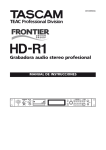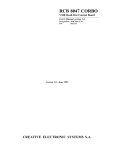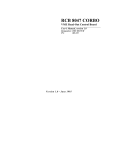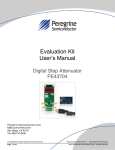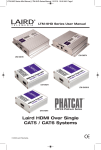Download Tascam RS-232C HD-R1 User's Manual
Transcript
TASCAM HD-R1 Serial Control port RS-232C Protocol Specification Document Ver. 1.00 September 2008 TEAC Corporation 1. Overview You can control the HD-R1 from a computer or other external device using its RS-232C port. In this document, the HD-R1 is the controlled device, and the external device that controls it is the control device. 2. Specifications Electrical specifications Applicable standard Receiver impedance Sender open circuit voltage Receiver open circuit voltage Signal discrimination JIS X-5101 (equivalent to old JIS C-6361 and EIA RS-232C) (Not compatible with RS-422A in commercial use VCRs and other equipment) 3 KΩ or more measured at applied voltage of ±3 – ±25 V ±25 V or less ±3.3 or less Logic “1” +2 V or more Logic “0” +0.8 V or more Transmission specifications Circuit format Three-wire, half duplex Transmission format Digital binary serial transmission Data signal speed 9600 bit/sec Character length 8 bits Parity bit None Stop bit 1 bit Note: The settings are fixed for the data signal speed, character length, parity bit and stop bit. The control device must be adjusted to match the HD-R1 settings. Pin configuration Connector D-sub 9-pin female (inch screw thread) Port pin allocations and input and output signals Pin In/Out Signal number 1 NC Not used 2 In Rx Data Receive data* 3 Out Tx Data Send data 4 NC Not used 5 GND Ground 6 NC Not used 7 NC Not used 8 NC Not used 9 NC Not used *Raise the voltage of Rx Data to comply with the RS-232C standard. 2 Description TEAC Corporation Controlled device (this unit) Control device 3. Command format 3.1 Command format overview The serial protocol was designed to be able to function using common terminal programs. Therefore, all markers are printable 8-bit ASCII characters, and the end of line marker is flexible. Unless otherwise indicated, character strings are not case sensitive. Every message has the same structure as indicated below, but some messages do not contain all the fields defined below. Parameter ID: A string of 1–24 characters specifies the parameter handled, including queries. Spaces before and after parameter character strings are ignored. Unless otherwise indicated, character strings are not case sensitive, and do not contain equal signs, question marks or exclamation points. Command: One character defines what the command does. This is the same for queries. Commands include “=” (set value) and “?” (query). Value: Strings are of 1 to 24 characters, including query values. Spaces before and after character strings are ignored. Unless otherwise indicated, character strings do not distinguish between upper and lower case characters. End Marker: One or two character strings. Both a carriage return followed by a line-feed (CR LF) and a line-feed (LF) are valid. The HD-R1 always accepts either type of end marker, and it can also send them. Below is an example of a typical message. There are no blank spaces inserted after the Parameter ID and Value character strings, and one end marker character string is used. 3 TEAC Corporation The command format is as follows. Parameter ID Character string Input Source Cmd Value End Marker = Analog/Mic LF (or CR+LF) ASCII codes 73 110 112 117 116 32 83 111 117 114 61 65 110 97 108 111 103 47 77 10 (decimal) 99 101 105 99 Conventions In this document commands sent to the HD-R1 are indicated as follows. Input Source? Responses from the HD-R1 are indicated in italic. Input Source=Analog/Mic 3.2 Explanation of command types and concrete examples Input commands Parameter query When the input message command field contains a “?” (question mark), the message is a parameter query command. If a parameter is not recognized or does not support this function, the HD-R1 will return an error message. Otherwise, it will respond with the current value of the parameter. The following is an example of a command that requests the current value of a parameter and the response from the HD-R1. Input Source? Input Source=Analog/Mic Set parameter When the input message contains an equal sign in the command field, the message is a set parameter command. When the HD-R1 receives a set parameter command, it will set the parameter as requested if conditions make it possible and the value is valid. If the parameter is set successfully, the HD-R1 will not respond. If the parameter is not recognized or the value is not valid, it will respond with an error. Usually, character strings for the parameter IDs and their values match the text shown on the LCD user interface screen. The following is an example of a command that sets a parameter. Input Source=Analog/Mic 4 TEAC Corporation Output commands Parameter value response When the command field of a message being set contains “=” (equal sign), the HD-R1is reporting the current value of the parameter. Usually, character strings for parameter IDs and their values match the text shown on the LCD user interface screen. For example: Input Source? Input Source=S/PDIF Error responses When the command field of a message being sent to it contains “?” (question mark), if the HD-R1 cannot interpret the received message it reports an error. For example, the HD-R1 will respond as follows if it receives a parameter query for an invalid parameter called “Blah.” Blah? Blah??? If the HD-R1 receives an invalid parameter set command, it will respond as follows. Blah=Foo Blah???Foo Set value refusal responses If the HD-R1 receives a parameter set command for a valid parameter, but the value is invalid, the HD-R1 will respond with “!” (exclamation point) added to the command field. Input Source=Blah Input Source!Blah If the HD-R1 receives a parameter set command for a valid parameter, but the value is missing, the HD-R1 will respond as follows. Input Source= Input Source!Missing Value Some parameters can be applied only when the transport is stopped. If you try to change one of these parameters when the transport is not stopped, the HD-R1 responds with “*” (asterisk). For example, if you try to change the sampling frequency while recording, the HD-R1 will respond as follows. WAV Sample Rate=44.1 kHz WAV Sample Rate*44.1 kHz Special incoming commands End markers By sending a line feed (LF) or carriage return and line feed (CR LF), the HD-R1 can be informed of the end of a message. The HD-R1 can accept this query or command at any time. After turning the power on, the end marker is set to CR LF by default. The following are end marker setting commands. End Marker=LF End Marker=CR LF 5 TEAC Corporation Protocol width Since fixed parameter widths for messages might be preferable depending on the device, the HD-R1 can be set to either fixed or variable parameter width using a message. When set to fixed, both the parameter ID and the value are padded with blank spaces to make them 24 characters. The HD-R1 can accept this query or command at any time. After turning the power on, the parameter width defaults to variable. Protocol Width=Fixed Protocol Width=Variable Logging in After turning the power on, the HD-R1 requires the Login password before responding to End Marker and Protocol Width commands. The HD-R1’s password is case sensitive, and the default password is “hdr1.” The login password can be changed through the front panel. Login=hdr1 Login Succeeded Logging Out By sending the following command after logging in, you can log out of the session. Logout Logged Out Software Version Sending this command causes the HD-R1 to reply with the current software version number. Version? Version=1.0 4. Command details 4.1 Direct transport commands Since the potential behavior of keys (PLAY, STOP, etc.) changes depending on the current transport state, sometimes they do not respond as intended. Direct transport commands do not depend on the current transport state, however, and this can be advantageous in some circumstances. For example, by sending a “Record” direct transport command, the HD-R1 should start recording immediately. The following is an example of the usual format of a direct transport command. Parameter ID Character string Transport Cmd Value End Marker = LF (or CR+LF) <Value> 6 TEAC Corporation The following is a list of direct transport commands. Value (character string) Functions Stop Stops the transport Play Starts playback Record Starts recording Ready Puts unit in ready to play mode Monitor Puts unit in ready to record mode First Track Moves to first track Next Track Moves to next track Prev Track Moves to previous track Last Track Moves to last track Next Track/Marker Moves to next track or next marker Prev Track/Marker Moves to previous track or previous marker 7 TEAC Corporation The following are valid commands when the transport is stopped. Value (character string) Function First Folder/Playlist Moves to first folder or first playlist in playback mode Next Folder/Playlist Moves to next folder or next playlist in playback mode Prev Folder/Playlist Moves to previous folder or previous playlist in playback mode Last Folder/Playlist Moves to last folder or last playlist in playback mode The following are examples of transport state queries. Value (character string) Meaning Transport? Asks for the transport state Transport=Record Example HD-R1 response The following are examples of other state queries. Value (character string) Meaning Current Track Number? What is the current track number? Total Time Elapsed? What is the total elapsed time? Event Elapsed? What is the elapsed time? Event Remaining? What is the remaining time? 8 TEAC Corporation 4.2 Setting commands Most of the HD-R1’s settings can be configured remotely. Their parameter IDs and acceptable values are defined in the following tables. With some exceptions, all parameters may both be set and queried with a command. Although they are not case sensitive, blank spaces within parameter IDs and setting values must be exactly as shown. The format for setting commands is the same as for others as shown in the example below. Parameter ID Character Auto Cue (example) string Command Setting value End Marker =: set value <Value>: as necessary LF (or CR+LF) ?: query The following can be set and queried at any time. Parameter ID Valid values Num Of Folders Total number of folders (query only) Num Of Playlists Total number of playlists (query only) Repeat Off On Auto Ready Off On Auto Cue Off -72 dBFS -66 dBFS -60 dBFS -54 dBFS -48 dBFS -42 dBFS -36 dBFS -30 dBFS -24 dBFS Channels Mono Left Mono Right Mono Summed Stereo WAV Sample Width 16 Bits 24 Bits 9 TEAC Corporation Mono MP3 Bit Rate 32 kbps 40 kbps 64 kbps 80 kbps 96 kbps 112 kbps 128 kbps 160 kbps Stereo MP3 Bit Rate 64 kbps 80 kbps 128 kbps 160 kbps 192 kbps 224 kbps 256 kbps 320 kbps Mark Audio Overs Off On Mark Time Interval Off 1 minute 2 minutes 3 minutes 4 minutes 5 minutes 10 minutes 30 minutes 60 minutes Auto Track 512 MB 1 GB 1.5 GB 1.8 GB 2 GB 5 Min 10 Min 15 Min 30 Min 1 Hour 10 TEAC Corporation Sync Record Off -72 dBFS -66 dBFS -60 dBFS -54 dBFS -48 dBFS -42 dBFS -36 dBFS -30 dBFS -24 dBFS Audio File Base Name Base name (up to 20 alphanumeric characters, including ‘-’, ‘_’ and ‘ ’) Mark Base Name Base name (up to 20 alphanumeric characters, including ‘-’, ‘_’ and ‘ ’) Shuttle Mode Track/Mark Only Hours Minutes Seconds Tenths Time Display Total Elapsed Total Remaining Event Elapsed Event Remaining Keyboard Type English Japanese Overload Threshold -0.2 dBFS 0 dBFS Overload Hold Flash 3 Sec 6 Sec 10 Sec Infinite Peak Decay Rate Hold Fast Decay Medium Decay Slow Decay Off 11 TEAC Corporation Meter Decay Rate Fast Decay Medium Decay Slow Decay Parallel Mode Off Direct Play Binary Play Program Play Input Polarity Active Low Active High Busy1 Signal Playback Recording Finished Ducking CF Door Media Full Busy1 Polarity Normally Open Normally Closed Busy2 Signal Playback Recording Finished Ducking CF Door Media Full Busy2 Polarity Normally Open Normally Closed System Time Hours: minutes: seconds System Date Day/month/year The following settings can be queried at any time but can only be changed when the transport is stopped. Attempting to change them while the transport is not stopped will result in an error command being sent back with an “*” (asterisk). Parameter ID Valid values Folder Name Folder name (case sensitive) Playlist Name Playlist name (case sensitive) Folder Number Folder number Playlist Number Playlist number 12 TEAC Corporation Playback Mode All Single Folder Playlist Folder Sorting Time Name Random On Off Input Source Analog/Mic S/PDIF WAV Sample Rate 44.1 kHz 48 kHz 82.2 kHz 96 kHz MP3 Sample Rate 44.1 kHz 48 kHz File Format WAV MP3 Pre-Record Off On Ref Level -20 dBFS = +4 dBu -18 dBFS = +4 dBu -16 dBFS = +4 dBu -14 dBFS = +4 dBu -9 dBFS = +6 dBu Ducking Mode Off Attenuate Input Attenuate Playback Ducking Threshold -6 dBFS -12 dBFS -18 dBFS -24 dBFS -30 dBFS 13 TEAC Corporation Ducking Attenuation -3 dB -6 dB -9 dB -12 dB -18 dB -24 dB -Infinity Ducking Hold Time 0.1 Sec 0.5 Sec 1.0 Sec 1.5 Sec 2.0 Sec 2.5 Sec 3.0 Sec 3.5 Sec 4.0 Sec 4.5 Sec 5.0 Sec 14 TEAC Corporation 4.3 Checking playlists and folders These commands allow you to check which playlists and folders can be used currently. The following are concrete examples. 1. Check the total number of playlists Use this to check how many playlists are on the currently inserted CF card. Command Query HD-R1 response Num Of Playlists? Num Of Playlists=3 This shows that there are three playlists on the CF card. 2. Check the playlist name Please note that playlists are in alphabetical order. Command Query HD-R1 response Playlist Name?1 Playlist Name=Jazz This shows that the name of the first playlist is “Jazz”. Use this command to check the name of the second playlist. Command Query HD-R1 response Playlist Name?2 Playlist Name=Rock This shows that the name of the second playlist is “Rock”. 3. Name a playlist Input a command like the following to set the name of the playlist. Command character string Playlist Name=Rock This will name the playlist unless there is an error. 4. Add a playlist number Input a command like the following to set the number of a playlist. Command character string Playlist Number=2 The setting will be made unless there is an error. 15 TEAC Corporation 5. Check the total number of folders Command Query HD-R1 response Num Of Folders? Num Of Folders=3 This shows that the total number of folders on the CF card is 3. 6. Folder name query Please note that playlists are in alphabetical order. Command Query HD-R1 response Folder Name?1 Folder Name=Monday This shows that the name of the first folder is “Monday”. Use this command to check the name of the second folder. Command Query HD-R1 response Folder Name?2 Folder Name= Tuesday This shows that the name of the second folder is “Tuesday”. 7. Name a folder Input a command like the following to set the name of the folder. Command character string Folder Name=Tuesday The setting will be made unless there is an error. 8. Add a number to a folder Input a command like the following to set the number of a folder. Command character string Folder Number=2 The setting will be made unless there is an error. 16 TEAC Corporation

















![K:\MC101\MANUAL\MCUMAN.WP [PFP#1000380182]](http://vs1.manualzilla.com/store/data/005961807_1-b45effbc6fddb6b40038078ec2dfc3bb-150x150.png)


